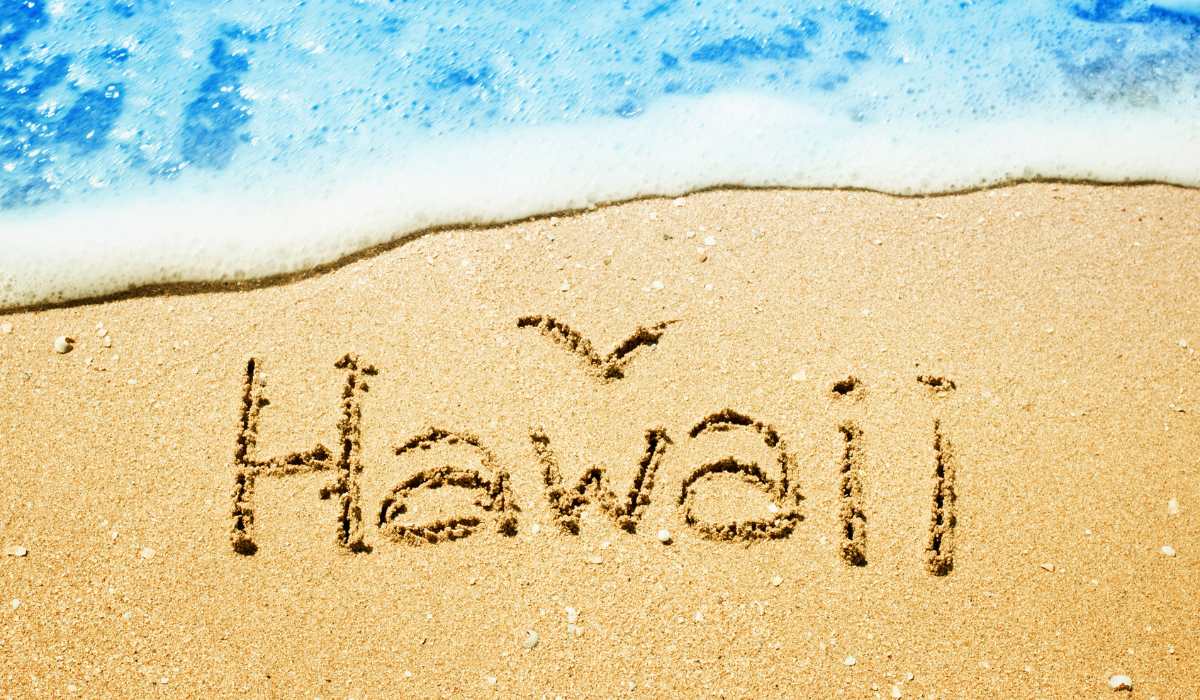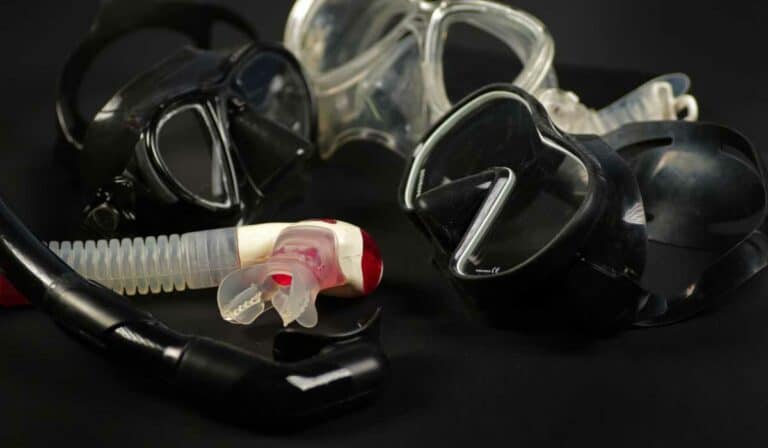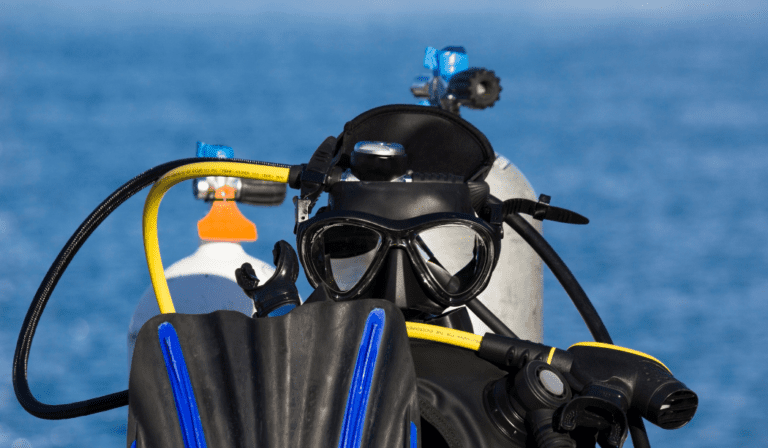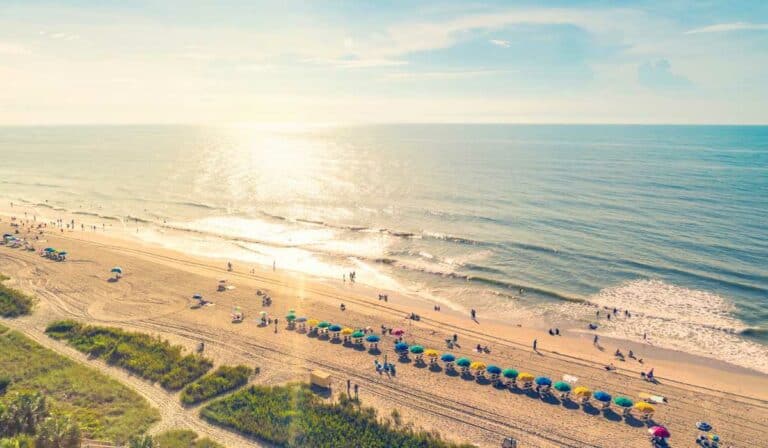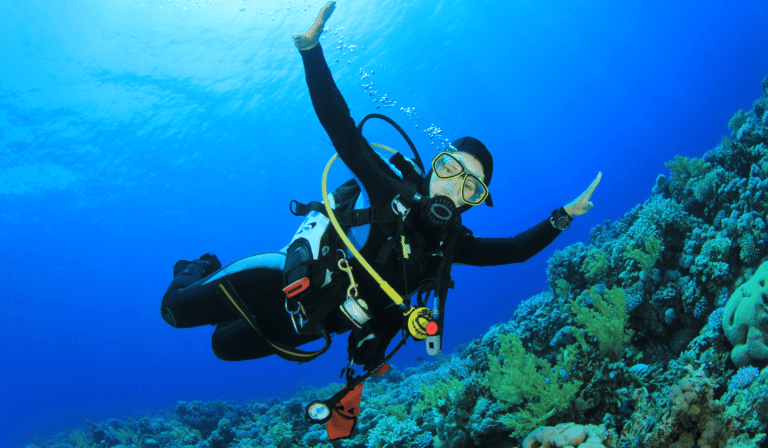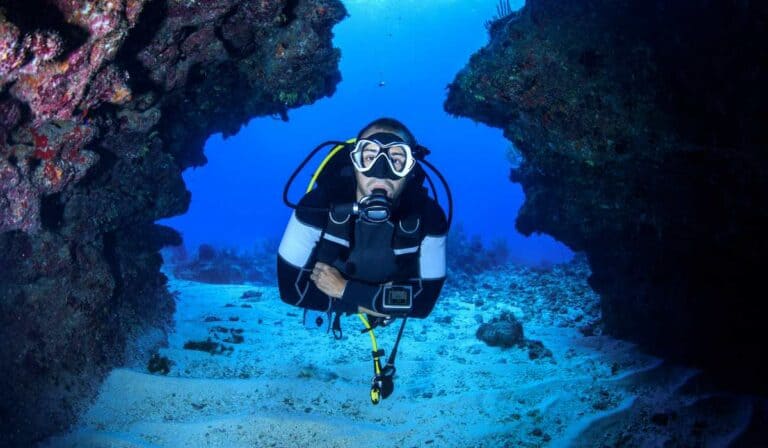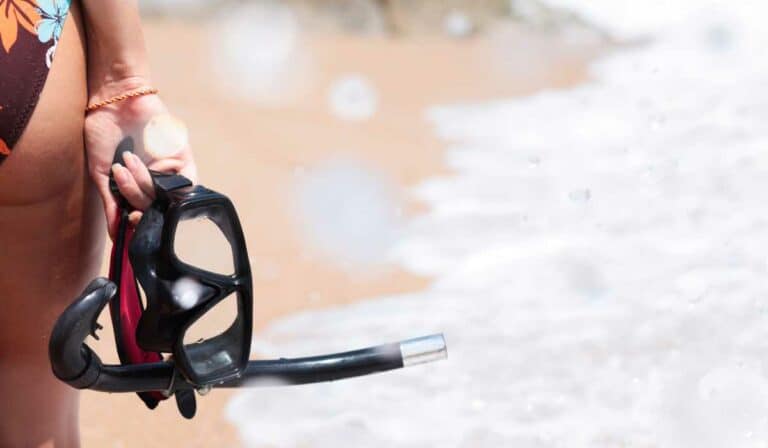5 Best Places for Scuba Diving in Hawaii
Discovering the best places for scuba diving in Hawaii is an experience like no other. The Hawaiian Islands offer a fascinating underwater topography, teeming with marine life and unique dive sites that cater to both recreational and experienced divers alike. In this article, we’ll take you on an exploration of the most renowned dive sites in Hawaii.
In this blog post, we’ll give you the lowdown on what to bring along for your scuba diving in Hawaii, how to decide which dive spot suits your expertise and tastes best, advice on having a great time beneath the ocean’s surface in these islands of volcanic beauty – plus some important safety points that should be kept in mind when planning a Hawaiian underwater adventure.
So sit back and let us guide you through the best places for scuba diving in Hawaii – where unforgettable experiences await beneath the waves of the Pacific Ocean.
Table of Contents
Exploring the Best Places for Scuba Diving in Hawaii

Hawaii is an aquatic utopia for scuba divers, with its sparkling waters, abundant marine life, and captivating seascapes. Discover the best places for scuba diving in Hawaii that should be on your next adventure.
1. Molokini Crater
Molokini Crater is one of the most popular dive spots in Hawaii and for good reason. This crescent-shaped volcanic crater offers excellent visibility and a wide variety of marine life. The Back Wall at Molokini is an advanced dive site featuring dramatic drop-offs and sightings of sharks, rays, turtles, and more.
2. Cathedrals I & II – Lanai Island
Lanai Island boasts two incredible underwater lava formations known as Cathedrals I & II. These unique structures are filled with tunnels and caverns that create cathedral-like chambers when sunlight filters through their openings. Divers can expect encounters with white-tip reef sharks, eagle rays, octopuses, and other amazing creatures.
3. Turtle Town – Maui
If swimming alongside Hawaiian green sea turtles sounds like your idea of fun, then Turtle Town on Maui’s south coast is not to be missed. This popular spot is renowned for its copious numbers of turtles and its kaleidoscopic coral gardens, making it a beloved destination for divers and snorkelers.
4. Two Step – Big Island
Two Step on the Big Island offers easy shore access and an incredible underwater landscape teeming with marine life. From colorful reef fish to spinner dolphins, this dive site has something for everyone.
Click here to read about Diving in the Lone Star State: The Best Places to Scuba Dive in Texas
5. Manta Ray Night Dive – Kona Coast
No trip to Hawaii would be complete without experiencing the world-famous Manta Ray Night Dive off the Kona coast. As night falls, giant manta rays come close to shore in search of plankton attracted by underwater lights set up by tour operators. Divers have the opportunity to witness these graceful creatures up close as they perform acrobatic flips while feeding.
Discover the astonishing sights that await you when exploring the depths of Hawaii’s waters by scuba diving. With so many amazing sites spread across different islands, there’s always more adventure waiting around every corner.
Uncovering the ultimate scuba spots in Hawaii is a remarkable journey, with stunning sights and one-of-a-kind aquatic creatures. With proper preparation, you can make sure your next trip for Scuba Diving in Hawaii is a success by packing all of the necessary items for a safe and enjoyable adventure.
Key Takeaway:
Discover the best sports for Scuba Diving in Hawaii, including Molokini Crater with its dramatic drop-offs and diverse marine life, Cathedrals I & II on Lanai Island featuring unique underwater lava formations filled with tunnels and caverns, Turtle Town on Maui’s south coast where you can swim alongside Hawaiian green sea turtles.
Two Step on Big Island offering easy shore access to a vibrant coral reef landscape teeming with marine life, and the world-famous Manta Ray Night Dive off Kona Coast where giant manta rays perform acrobatic flips while feeding. Don’t pass up the extraordinary escapades in store for you in Hawaii.
GEAR FOR SCUBA DIVING IN HAWAII

Packing the right gear and essentials can make all the difference when embarking on a scuba diving adventure in Hawaii. From equipment to clothing, here are some must-have items that will ensure you have an enjoyable experience underwater.
Essential Scuba Gear
- Dive mask: A good quality dive mask is crucial for clear vision underwater. Make sure it fits comfortably and provides a proper seal around your face.
- Snorkel: Although not required for scuba diving, having a snorkel handy allows you to conserve air while exploring the surface before or after your dive.
- Fins: Choose fins that fit well and provide adequate propulsion without causing discomfort during extended use.
- Buoyancy Control Device (BCD): An essential piece of equipment that helps maintain neutral buoyancy throughout your dive, allowing you to control your depth easily.
- Regulator set: This includes both primary and secondary regulators (octopus), as well as gauges displaying tank pressure, depth, and sometimes compass information.
If you don’t own these items or prefer not to travel with them, most Hawaiian dive shops offer rental options at reasonable prices.
Exposure Protection & Clothing
In addition to standard swimwear like swimsuits or board shorts, consider packing the following exposure protection gear based on water temperatures during your trip:
- Wetsuit or drysuit: Depending on the time of year and location, water temperatures in Hawaii can range from 70°F to 80°F. A wetsuit or dry suit will help keep you warm during your dive.
- Rashguard: This lightweight garment provides additional sun protection when worn under a wetsuit or alone for snorkeling sessions.
- Dive booties: Protect your feet from sharp rocks and coral while providing extra grip on slippery surfaces.
Additional Items & Accessories
Beyond essential gear and clothing, consider packing these items to enhance your experience of scuba diving in Hawaii:
- Dive computer: An invaluable tool that tracks depth, bottom time, ascent rate, and more – helping you stay safe underwater.
- Underwater camera or GoPro: Capture memories of the stunning marine life you encounter during your dives with an underwater camera or action cam like a GoPro.
- First aid kit: A basic first aid kit containing band-aids, antiseptic wipes, seasickness medication (if prone), and any personal medications is always good to have on hand during outdoor adventures.
Remember to pack all necessary chargers for electronic devices as well.
Taking the time to properly prepare for your scuba diving trip in Hawaii by packing appropriate gear ensures that you’ll be able to focus solely on enjoying the incredible underwater world around you.
Click here to read about Discover the 5 Best Beach Cities for Scuba Diving
What to Pack for a Scuba Diving Trip in Hawaii
Preparing for your scuba diving escapade in Hawaii is a thrilling undertaking, but it’s critical to take the correct apparatus and possessions to guarantee a safe and delightful time. In this section, we’ll cover the essentials you need to bring on your trip, from dive equipment to clothing and other useful items.
A. Dive Equipment
The most important aspect of packing for any scuba diving trip is ensuring that you have all the necessary dive equipment. While many dive operators offer rental gear, bringing your own can provide added comfort and familiarity during your dives. Here are some key pieces of equipment you should consider packing:
- Dive mask
- Snorkel
- Fins (open heel with booties or full foot)
- Wetsuit or dive skin (appropriate thickness depending on water temperature)
- The buoyancy control device (BCD) – optional if renting from a local operator
- Regulator set – optional if renting from a local operator
B. Clothing & Personal Items
In addition to your dive gear, it’s crucial to pack appropriate clothing and personal items for both underwater adventures as well as exploring the beautiful Hawaiian Islands above sea level:
- Swimsuit
- Rashguard or dive shirt for sun protection
- Comfortable, quick-drying clothing for land activities
- Sunscreen (reef-safe)
- Sunglasses and a hat for sun protection
- Towel
- Reusable water bottle
- Camera or underwater camera
- Small first aid kit
- Cash or credit card for dive fees, tips, and souvenirs
By packing these essential items, you’ll be well-prepared for your scuba diving adventure in Hawaii. Remember to double-check your gear and items before departing to ensure a stress-free and enjoyable trip.
Be sure to pack all the necessary items for a safe and enjoyable scuba diving trip in Hawaii, such as your dive gear, wetsuit or drysuit, fins, and masks. Once you have all the necessary equipment, selecting an appropriate dive site for your excursion is a critical step.
CHOOSING THE RIGHT DIVE SITE

Deciding on the best dive site in Hawaii for you can be a challenge, given all of its amazing options; so consider your skill level to make sure it’s an unforgettable experience. To make your decision easier and ensure you have an unforgettable experience, consider these factors when choosing a dive site:
Assess Your Skill Level
One’s capability when it comes to scuba diving is an important element in selecting the appropriate dive site. If you’re new to diving or still working on improving your skills, it’s best to stick with beginner-friendly sites that offer shallow depths and calm waters. Some great options include Hanauma Bay on Oahu and Molokini Crater off Maui.
Determine Your Interests
Hawaii offers diverse underwater environments that cater to different interests. Are you looking forward to exploring colorful coral reefs teeming with marine life? Or do shipwrecks fascinate you more? For reef enthusiasts, check out Kapoho Tide Pools on Big Island or Shark Cove on Oahu. If you’re into shipwrecks, don’t miss the Sea Tiger Wreck off Waikiki or the Carthaginian II Wreck near Lahaina, Maui.
Consider Seasonal Factors
Hawaii’s dive sites can vary greatly depending on the time of year. For example, during winter months (November to February), some areas experience rougher seas and reduced visibility due to increased wave activity. On the other hand, the summer months (May to September) often bring calmer waters and better visibility for diving. Be sure to research seasonal factors at your chosen site before booking your trip.
Seek Local Expertise
Talking with local divers or joining a reputable scuba diving tour operator can provide invaluable insights into choosing the right dive site for you. They’ll be able to recommend locations based on current conditions and share their knowledge about specific sites’ unique features.
Incorporating these considerations will help ensure that you select a dive site in Hawaii that matches both your skill level and interests while providing an unforgettable underwater adventure.
Before deciding on a dive spot, make sure to factor in the type of diving you wish to do and which conditions are most suitable for your needs. With these tips in mind, you’ll be ready for an enjoyable scuba experience in Hawaii. Now let’s look at some useful tips for making the most out of your time underwater.
Key Takeaway:
To choose the best dive site in Hawaii, consider your skill level, interests, and seasonal factors. Stick to beginner-friendly sites like Hanauma Bay or Molokini Crater if you’re new to diving. Seek local expertise from scuba diving tour operators or experienced divers for invaluable insights into choosing the right dive site for you.
Click here to read about A Guide To Scuba Diving in Honduras
Tips for Enjoying Your Dive in Hawaii
To maximize the enjoyment of your Hawaiian dive, here are some tips to capture amazing photos and videos as well as spot remarkable marine life. From capturing stunning photos to spotting incredible marine life, here are some tips to help you enjoy every moment of your dive.
Take Photos and Videos
Hawaii’s vibrant coral reefs and diverse marine life provide endless opportunities for photography enthusiasts. To capture these breathtaking moments, invest in a quality underwater camera or housing for your existing camera. Practice taking photos at different depths and lighting conditions to ensure you get the perfect shot during your dive.
Spotting Marine Life
The Hawaiian Islands are home to various species of fish, turtles, sharks, dolphins, whales, and other fascinating creatures that can be seen while scuba diving. Familiarize yourself with the types of marine life native to Hawaii, so you know what species you might encounter on each dive site. Pay attention to their behavior patterns as well; this will increase your chances of spotting them during dives.
- Turtles: Green sea turtles (honu) can often be found resting near coral formations or munching on algae-covered rocks.
- Fish: Keep an eye out for colorful reef fish like butterflyfishes or angelfishes swimming around corals or hiding among crevices.
- Manta Rays: Manta rays glide gracefully through open water areas feeding on plankton, and some dive sites offer night dives to see these gentle giants up close.
- Sharks: While most sharks in Hawaii are harmless, always maintain a respectful distance and avoid disturbing them. Reef sharks like whitetip reef sharks or blacktip reef sharks can be seen patrolling the reefs during day dives.
Appreciate the Scenery
Hawaii’s underwater landscapes are just as stunning as its above-water scenery. Take time to admire the beautiful coral formations, lava tubes, caverns, and other unique geological features that make each dive site special. Remember not to touch or disturb any corals or marine life – practice good buoyancy control and follow responsible diving practices.
Buddy Up with Fellow Divers
Diving is even more enjoyable when experienced with others who share the same enthusiasm for discovering the depths of the sea. Joining a group of divers on your trip will not only enhance your experience but also provide an opportunity to learn from one another’s expertise and insights about different dive sites in Hawaii.
Prepare to embark on a remarkable scuba diving journey in Hawaii with these tips.
For a safe and enjoyable diving experience in Hawaii, it’s wise to take into account certain tips. Before plunging into the depths of Hawaii’s waters, ensure you are aware of all safety protocols to guarantee a safe and enjoyable dive.
Key Takeaway:
Invest in a top-notch underwater camera to take amazing pics and videos of your scuba diving adventure in Hawaii. Familiarize yourself with the types of marine life native to Hawaii and appreciate the beautiful coral formations while practicing good buoyancy control and following responsible diving practices.
Safety Considerations When Scuba Diving in Hawaii

Scuba diving in Hawaii can be an incredible experience, but it’s essential to prioritize safety while exploring the underwater world. By being aware of potential hazards and following proper guidelines, you can ensure a safe and enjoyable dive. In this section, we’ll discuss some important safety considerations when scuba diving in Hawaii.
Awareness of Currents and Weather Conditions
Currents around the Hawaiian Islands can be strong and unpredictable at times. It’s crucial to research local conditions before your dive or consult with experienced divers or marine life conservation districts. Be prepared for changing weather conditions as well; sudden storms may affect visibility or create rough seas that make diving more challenging.
Avoiding Dangerous Wildlife Encounters
Hawaii is a habitat for numerous aquatic creatures, such as sharks, eels, and other potentially hazardous species. While encounters are rare, if you maintain a respectful distance from wildlife and avoid touching anything underwater, the risk of injury will be minimized. Additionally, always pay attention to any warnings about increased shark activity near specific dive sites.
Tips for Avoiding Dangerous Marine Life
- Maintain a safe distance from all wildlife – do not touch or harass them.
- Be cautious around coral reefs where eels often hide during daytime hours.
- If you encounter a shark: remain calm; do not thrash around; slowly back away without turning your back on it;
- Wear gloves to protect your hands from sharp objects or stinging marine life.
Staying Within Your Skill Level and Experience
It’s essential to choose dive sites that match your skill level and experience. Beginners should stick to shallow, calm waters with clear visibility, while more advanced divers can explore deeper or more challenging sites. If you’re unsure about a particular location, consult with local dive shops or experienced divers for advice on suitable spots for your abilities.
Finding the Right Dive Buddy
- Select a buddy who has similar skills and experience as you do;
- Communicate openly about any concerns or limitations before diving;
- Establish hand signals for underwater communication;
- Create an emergency plan in case of separation during the dive.
Click here to read about Scuba Divers: 7 Essential Ways To Save The Oceans For the Future
Maintaining Proper Equipment Maintenance and Functionality
Ensuring the proper maintenance and functionality of your scuba gear is essential for a safe dive. Regularly inspect all equipment for signs of wear or damage, such as cracks in hoses or leaks in regulators. Make sure everything fits comfortably and functions correctly before entering the water. If renting gear from a local shop, double-check that it meets safety standards and ask staff members how often they perform maintenance checks.
In conclusion, to ensure your safety when scuba diving in Hawaii, always be aware of currents and weather conditions; avoid dangerous wildlife encounters; stay within your skill level; maintain proper equipment functionality; find the right dive buddy; and communicate effectively with others both above the water surface and below sea level.
FAQs about Best Places for Scuba Diving in Hawaii
What Hawaiian Island Has the Best Scuba Diving?
The Big Island of Hawaii is often considered the best for scuba diving due to its diverse marine life, clear waters, and unique underwater lava formations. However, each island offers excellent dive sites with varying conditions and experiences. For example, Maui is known for its shipwrecks, and Oahu is famous for its shark encounters.
Is Hawaii Good for Scuba Diving?
Hawaii is an excellent destination for scuba diving thanks to its warm tropical waters, high visibility levels, abundant marine life, including turtles and dolphins, as well as various types of coral reefs. The islands offer a wide range of dive sites suitable for beginners to advanced divers.
Is Scuba Diving Better on Maui or Oahu?
Both Maui and Oahu have fantastic dive sites that cater to different interests. Maui boasts impressive shipwrecks like the Carthaginian II, while Oahu features exciting shark encounters at spots such as Shark’s Cove. Your preference will depend on your personal interests in terms of marine life or specific underwater attractions.
What Are the Best Months to Scuba Dive in Hawaii?
The optimal time to go scuba diving in Hawaii is between April and October when water temperatures are warmer (75-80°F), and visibility tends to be higher (upwards of 100 feet). During these months, you can also expect calmer ocean conditions, which make it easier to explore various dive sites.
Conclusion
Exploring the underwater world of Hawaii is a truly unique experience. From crystal-clear waters to diverse marine life, there are so many incredible dive sites to explore. By packing the right gear and choosing a site that suits your skill level, you can have an unforgettable adventure.
Remember to always prioritize safety when scuba diving in Hawaii by following guidelines and listening to your instructor or guide. Prepare for an awesome excursion beneath the waves with these tips in mind.

